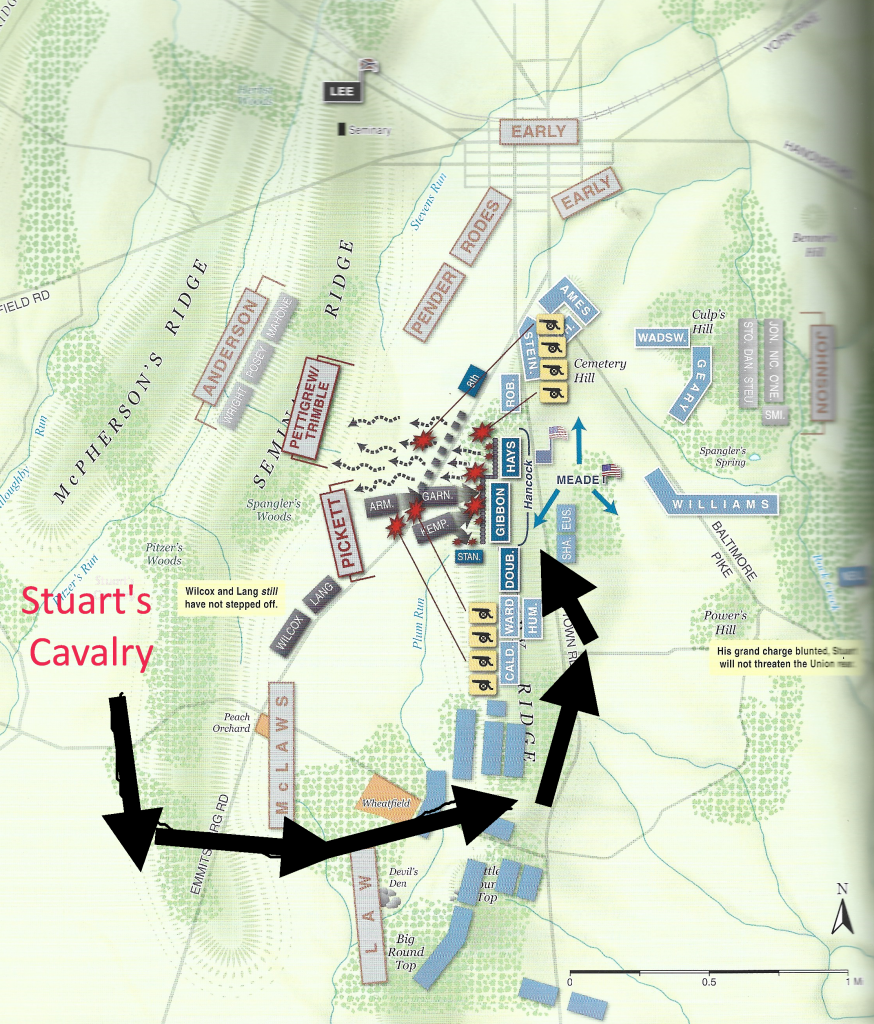7g.1 Stuart
It is possible to insert here a series of WHATIFs concerning just what it was that even Lee himself would have accepted as a successful outcome. He was truly at the end of his proverbial rope. He had no additional troops available to exploit any ‘success’ that afternoon. It forces one to place oneself on Traveler sitting in the woods on Seminary Ridge watching the debacle unfold and to try to see it as Lee was drinking in the realization that he had executed thousands of his men that afternoon.

One is almost forced to ask here if Stuart’s Cavalry was used to the best advantage in the supporting role that Lee assigned him. [see Section 7h] Might 6000 horsemen galloping across the valley following in Pickett’s wake have had an unsettling effect on the Union line? I suggest that Lee could have kept them more or less hidden along the Emmittsburg Road behind the orchard knoll. As the Union artillery and infantry concentrated their attention on Pickett’s infantry, Stuart could have been upon them in mere seconds, charging along Pickett’s right flank and into the Saddle (see Section 30h). The shock value alone would perhaps have prevented the Union line there from mounting an effective defense. Assuming that he could have sliced through that line, he’d have been in the direct path — the Taneytown Road — that Meade was using to bring in reinforcements. Stuart’s men could have created havoc.
Lee seemed to place a greater likelihood of success by having Stuart approach and possibly penetrate the Union rear by approaching from the east. Lee was wrong again!
7g.2 Anderson
In his official report written in late July 1863, LTG Longstreet provides facts not found elsewhere. Per his personal recollection, the attack started somewhat later than most other accounts. He states that it wasn’t until 2P.M. that the preliminary bombardment commenced. Although his account of what follows is in general agreement with what most historians think happened, he does not provide a time sequence for the length of the barrage nor for the totality of Pickett’s attack.
He does, however, address the question of support in the form of Anderson’s Division. Seemingly, although the chronology is not well defined, at about the time that BG Armistead’s Brigade reached the top of Cemetery Ridge, MG Anderson’s Division was ordered to move to support (exploit?) those gains. Longstreet fails to identify exactly who gave that order. But it was too little, too late. Before Anderson could move across the valley, Pickett’s survivors were already repulsed and retreating. Anderson’s advance was stopped before he could suffer the same fate as Pickett.
Although Longstreet’s account of the above events is short and somewhat vague, it does seem to address the issue that some thought was given to try to exploit any gains Pickett could make. Why Anderson was so far behind remains unanswered. Assuming that Longstreet’s account is accurate as written, why is Anderson’s Division never counted as participating in that day’s events?
